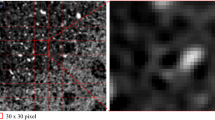Abstract
A new technique is reported for estimating the volume fraction of porosity in structural materials. The estimate for the volume fraction is proportional to the slope of the ultrasonic attenuation when plotted as a function of frequency. Both theory and experiment are considered. The theory, appropriate for dilute porosity, uses the uncorrelated, single-scatter approximation. An “attenuation slope” algorithm is derived within this approximation and its limits of validity are tested by computer simulation. Experimental tests consist of three parts. First, the method is compared with other existing techniques through estimates from the published data on gas porosity in aluminum casts. For the second test, cylindrical porosity is simulated by parallel through-holes drilled in aluminum blocks. Finally, the attenuation in porous graphite-epoxy samples is measured and compared with results predicted from theory.
Similar content being viewed by others
References
L. Adler, J. H. Rose, and C. Mobley,J. Appl. Phys. 59:336 (1986).
J. H. Rose, D. K. Hsu, and L. Adler,J. Phys. (Paris) Colloq., Suppl. 12(46):C10 (1985); J. H. Rose, inReview of Progress in Quantitative Nondestructive Evaluation, D. O. Thompson and D. E. Chimenti, eds. (Plenum, New York, 1986), Vol. 5B, p. 1617.
D. K. Hsu and K. M. Uhl, inReview of Progress in Quantitative Nondestructive Evaluation, D. O. Thompson and D. E. Chimenti, eds. (Plenum, New York, 1987), Vol. 6B, p. 1175.
J. E. Gubernatis and E. Domany, inReview of Progress in Quantitative Nondestructive Evaluation, D. O. Thompson and D. E. Chimenti, eds. (Plenum, New York, 1983), Vol. 2A, p. 833;Wave Motion 6:579 (1984).
A. G. Evans, B. R. Tittmann, L. Ahlberg, B. T. Khuri-Yakub, and G. S. Kino,J. Appl. Phys. 49:2669 (1978).
B. G. Martin,NDT Int. 9:242 (1976).
C. F. Ying and R. Truell,J. Appl. Phys. 27:1086 (1956).
T. S. Lewis, D. W. Kraft, and N. Hom,J. Appl. Phys. 47:1795 (1976).
Y. H. Pao and C. C. Mow,Diffraction of Elastic Waves and Dynamic Stress Concentrations (Crane and Russak, New York, 1973).
T. H. Tan,Appl. Sci. Res. 32:97 (1976).
J. H. M. T. van der Hijden and F. L. Neerhoff,J. Appl. Mech. 51:646 (1984).
M. O'Donnell, J. W. Mimbs, and J. G. Miller,J. Acoust. Soc. Am. 65(2):512 (1979).
D. K. Hsu and S. M. Nair, inReview of Progress in Quantitative Nondestructive Evaluation, D. O. Thompson and D. E. Chimenti, eds. (Plenum, New York, 1987), Vol. 6B, p. 1185.
Author information
Authors and Affiliations
Rights and permissions
About this article
Cite this article
Nair, S.M., Hsu, D.K. & Rose, J.H. Porosity estimation using the frequency dependence of the ultrasonic attenuation. J Nondestruct Eval 8, 13–26 (1989). https://doi.org/10.1007/BF00566584
Received:
Revised:
Issue Date:
DOI: https://doi.org/10.1007/BF00566584




